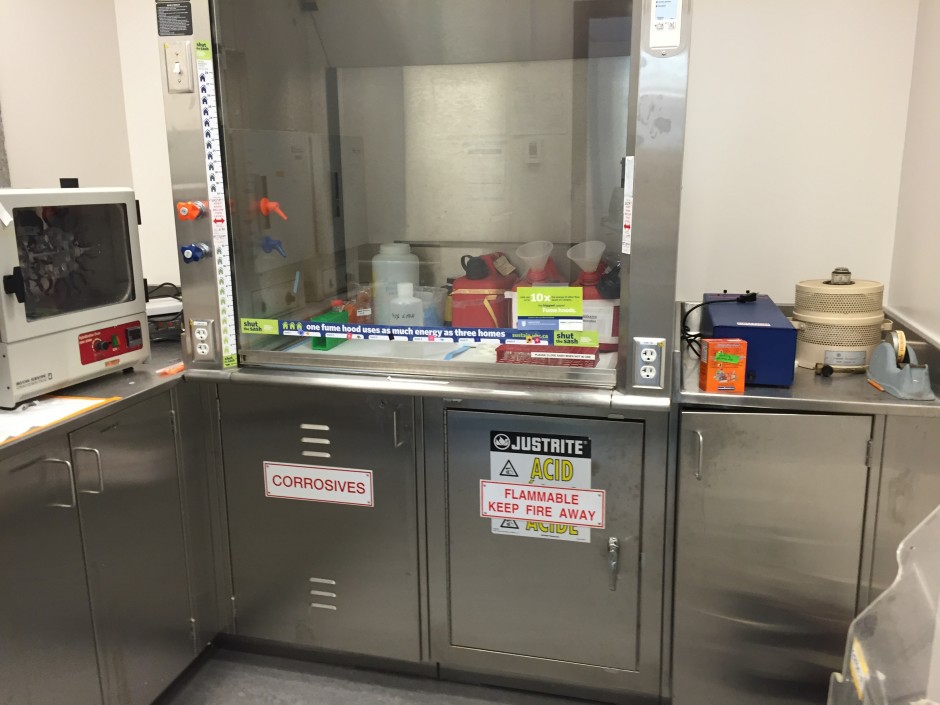
Non-Hazardous Materials
Non-hazardous material can be disposed of down the drain or with regular trash; please check the list below to find out if the chemicals you are using are classified as being harmless enough for drain or trash disposal:
Non-Hazardous Chemical Disposal
Hazardous Waste
Hazardous waste generated at UBC is processed at our Environmental Services Facility. Your lab should have unique barcode stickers, which must be affixed to waste items before their disposal. You may be denied jerry cans for waste collection or tags for labeling until you have your own barcode! If your lab does not have a roll of barcode stickers, or if you require new ones, contact the environmental services facility at 604-822-6303 or 604-822-1281. Once you have barcode stickers, jerry cans for solvent waste disposal and tags for waste labeling can be obtained from Botany/Zoology shipping-receiving (BIOSCI 1015). Waste is deposited for pickup in the storage rooms located on the loading dock outside of shipping-receiving area.
Solvent Waste
Solvents are separated in the jerry cans for disposal as oil, halogenated, and non-halogenated wastes. Obtain a blue tag for flammable liquid waste from stores, label it as oil/halogenate/non-halogenated, and affix your barcode sticker. Do this before beginning to use the can to collect waste. When the can is ready for disposal, that is, near full but not at risk of spilling, deposit it in the storage room at the loading dock for pick-up.
Contaminated Solid Waste
Examples of chemicals commonly used in some labs that necessitate that waste is disposed of separately include ethidium bromide, phenol, and osmium tetroxide. Collect solid waste (no liquids!) in strong, translucent bags. When you’ve accumulated enough waste for disposal, double bag waste and pack in a strong cardboard box. Do not exceed 10kg per load. Obtain a yellow tag for non-regulated contaminated waste from stores, label the tag for its contaminant, and affix your barcode sticker. Deposit in the storage room at the loading dock for pick-up.
Sharps Waste
Collect sharps in red or yellow sharps containers. Autoclave if necessary. Obtain a red tag from stores, affix your barcode sticker, and deposit in the storage room at the loading dock for pick-up.
Glass Waste
Collect clean glass waste in metal cans lined with strong, clear autoclave bags. Ensure that the weight of the can does not exceed 10kg before depositing in the storage room at the loading dock for pick-up.
Biological Waste Risk Groups 1 & 2
Collect biological waste in strong, clear autoclave bags. Autoclave, then double bag again using a strong, clear bag, and seal. Ensure there are no leaks, and that each waste bag weighs less than 10kg. Obtain a red tag for biological waste from stores, indicate whether the waste is group 1 or group 2, and affix your barcode sticker. Deposit in the storage room at the loading dock for pick-up. For risk group definitions, go to http://www.absa.org/riskgroups/index.html
Please note that any material that has been in contact with any kind of microorganism must be disposed of as biological waste; this includes media, pipette tips, and other lab consumables.
Soil Waste
All soil and plant waste should be autoclaved with autoclave tape, so it can be seen to have been autoclaved, and then put in the dumpster. No gloves, plates or anything that looks remotely like biological waste should be included.
Surplus Chemical Waste
Other chemical wastes need to be disposed of via the Hazardous Waste Inventory System (HWIS), formerly known as the Chemical Waste Inventory System (CWIS). If in doubt about disposal, submit it here and they will let you know if it is safe to go down the drain or in the regular garbage. Login to HWIS at
Hazardous Waste Inventory System (HWIS)
Input your chemical information and submit the information for approval by the Environmental Services Facility. Once your submission has been approved, separate you chemicals by hazard class as instructed on the waste disposal approval that you receive by email: flammable, corrosive, toxic, oxidant, acids, etc. Tightly pack chemical containers with absorbent material in strong cardboard boxes, and seal with packing tape. Ensure individual boxes weigh no more than 10kg. Print the approval form received from the environmental services facility, and affix, in an envelope, to the cardboard box. Write your contact information, the hazard class contained in the box, and the authorization number you received from the environmental services facility on the envelope. Deposit for pickup with other chemical waste in the storage room at the loading dock for pick-up.
Lab Coat Washing Service
We have a lab coat washing service setup for the department. Clearly label your lab coat with your name and your lab room number before dropping it off at Chem stores for cleaning. You can use your speed chart at the Chem stores. Coats are picked up every Tuesday, and are returned, cleaned, the following Tuesday. Lab coats will only be picked up if there are 10 or more stacked up in stores, so it is a good idea to collect coats within your lab and send these for washing at the same time.
The following document from Safety & Risk Services (SRS) is a convenient reference for waste disposal protocols at UBC:






